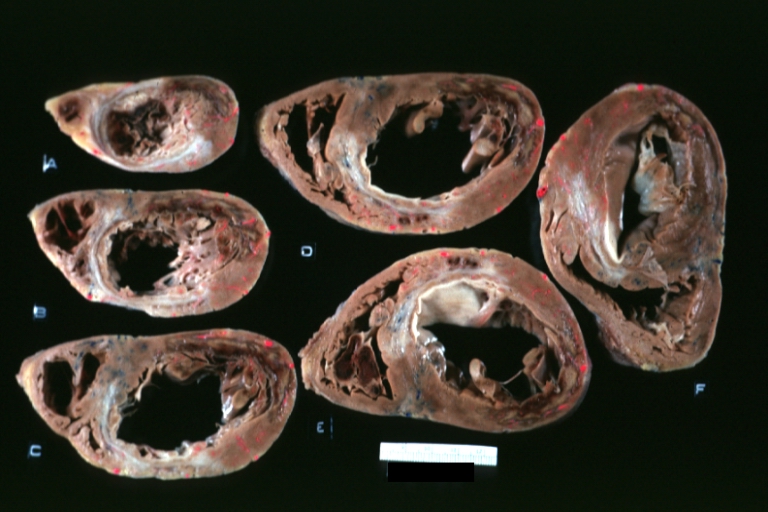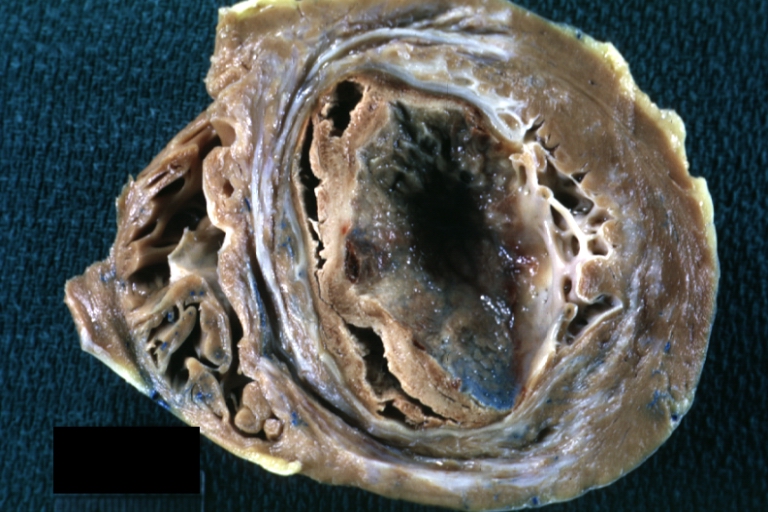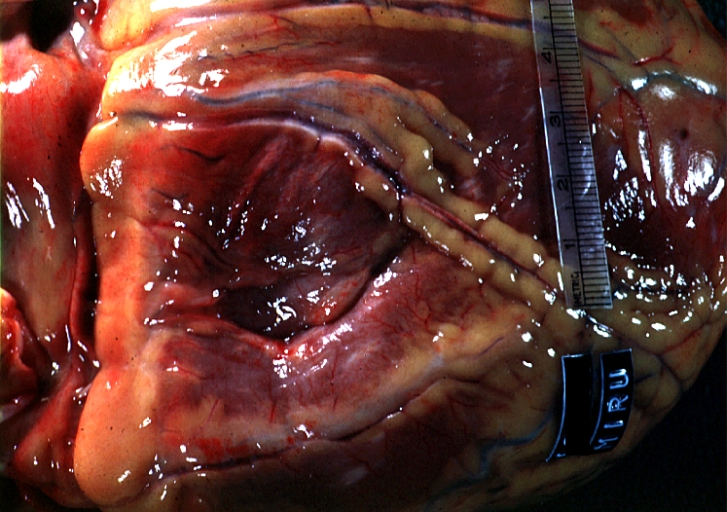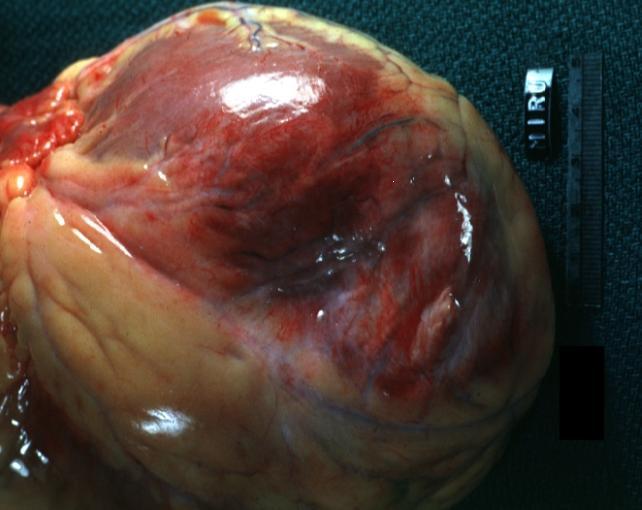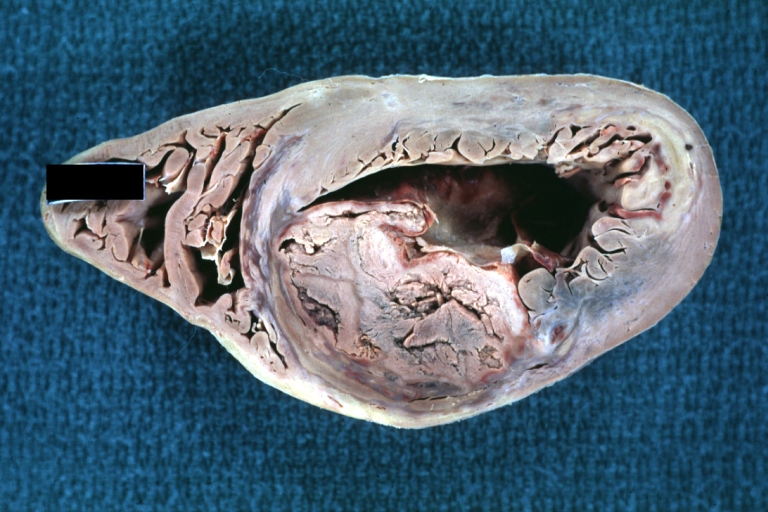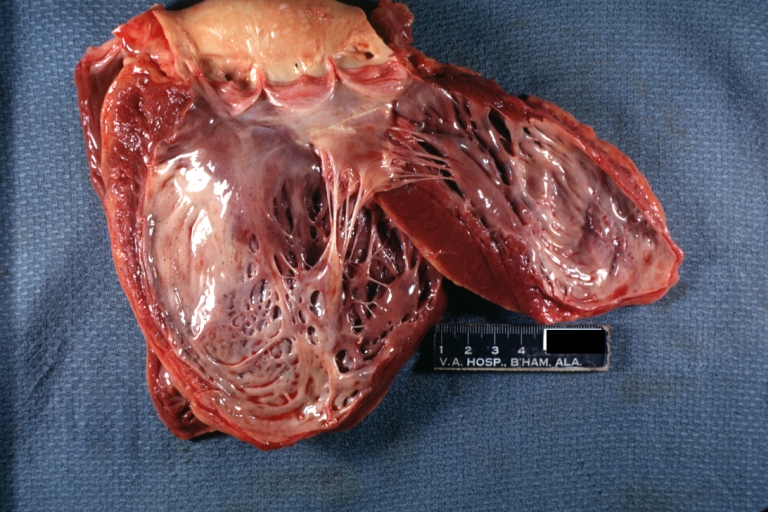ST elevation myocardial infarction gross pathology: Difference between revisions
No edit summary |
m (Bot: Removing from Primary care) |
||
| (15 intermediate revisions by 9 users not shown) | |||
| Line 1: | Line 1: | ||
{{ | __NOTOC__ | ||
{{ST elevation myocardial infarction}} | |||
{{CMG}}; {{AE}} {{CZ}} | |||
==Gross Pathology== | |||
Myocardial infarction can be classified temporally from clinical and other features, as well as according to the [[pathological]] appearance as:<ref name="pmid17951284">{{cite journal |author=Thygesen K, Alpert JS, White HD, ''et al'' |title=Universal definition of myocardial infarction |journal=Circulation |volume=116 |issue=22 |pages=2634–53 |year=2007 |month=November |pmid=17951284 |doi=10.1161/CIRCULATIONAHA.107.187397 |url=}}</ref> | |||
Myocardial | |||
* Evolving phase of myocardial infarction: (>6 hours), | * Evolving phase of myocardial infarction: (>6 hours), | ||
* Acute phase of myocardial infarction: (6 hours – 7 days), | * Acute phase of myocardial infarction: (6 hours – 7 days), | ||
* Healing phase of myocardial infarction: (7–28 days), | * Healing phase of myocardial infarction: (7–28 days), | ||
* Healed phase of myocardial infarction: (29 days and beyond). | * Healed phase of myocardial infarction: (29 days and beyond). | ||
Time from Onset and Gross Morphologic Finding Relations: | |||
* 18 - 24 hours: Pallor of [[myocardium]] | |||
* 24 - 72 hours: Pallor with some [[hyperemia]] | |||
* 3 - 7 days: [[Hyperemic flow|Hyperemic]] border with central yellowing | |||
* 10 - 21 days: Maximally yellow and soft with [[vascular]] margins | |||
* 7 weeks: White [[fibrosis]] | |||
===Images=== | |||
[http://www.peir.net Images courtesy of Professor Peter Anderson DVM PhD and published with permission © PEIR, University of Alabama at Birmingham, Department of Pathology] | [http://www.peir.net Images courtesy of Professor Peter Anderson DVM PhD and published with permission © PEIR, University of Alabama at Birmingham, Department of Pathology] | ||
{| align="center" | |||
! | |||
|- valign="top" | |||
| [[Image:Image15001.jpg|left|thumb|400px|Acute Myocardial infarction.]] | |||
| [[Image:Image15533.jpg|left|thumb|400px|Myocardial infarction, fibrosis. Right Coronary Artery's territory.]] | |||
|} | |||
[[Image:Image15533.jpg|left|thumb|400px|Myocardial infarction, fibrosis. Right Coronary Artery's territory.]] | |||
[[Image: | {| align="center" | ||
! | |||
|- valign="top" | |||
| [[Image:Image15973.jpg|left|thumb|400px|Acute Myocardial infarction; Posterior wall.]] | |||
| [[Image:Image917.JPG|left|thumb|400px|Gross example of myocardial infarction that is several weeks or perhaps months of age.]] | |||
|} | |||
[[Image: | {| align="center" | ||
! | |||
|- valign="top" | |||
| [[Image:Image919.JPG|left|thumb|400px|Acute myocardial infarction. Multi sliced view.]] | |||
| [[Image:Image905.JPG|left|thumb|400px|Gross example of acute infarction in fixed heart. Lesion is reflow necrosis stone heart also has old scar. Multisliced view.]] | |||
|} | |||
[[Image: | {| align="center" | ||
! | |||
|- valign="top" | |||
| [[Image:Old MI.jpg|left|thumb|400px|Old myocardial infarction with fibrosis and apical thrombus.]] | |||
| [[Image:Old MI with fibrosis.jpg|left|thumb|400px|Old myocardial infarction with fibrosis.]] | |||
|} | |||
[[Image: | {| align="center" | ||
! | |||
|- valign="top" | |||
| [[Image:AMI with epicardial fibrin.jpg|left|thumb|400px|Acute myocardial infarction with epicardial fibrin.]] | |||
| [[Image:Ruptured MI.jpg|left|thumb|400px|Myocardial infarction and rupture.]] | |||
|} | |||
[[Image: | {| align="center" | ||
! | |||
|- valign="top" | |||
| [[Image:MI and DM.jpg|left|thumb|400px|Myocardial infarction; free wall, 6 days old, in a patient with [[diabetes mellitus]] and [[hypertension]].]] | |||
| [[Image:MI and DM 2.jpg|left|thumb|400px|Myocardial infarction free wall, 6 days old, in a patient with [[diabetes mellitus]] and [[hypertension]].]] | |||
|} | |||
[[Image: | {| align="center" | ||
! | |||
|- valign="top" | |||
| [[Image:Anterior surface in APMI.jpg|left|thumb|400px|Anterior surface of the heart in patient with acute posterior myocardial infarction.]] | |||
| [[Image:Posterior surface of APMI.jpg|left|thumb|400px|Posterior surface of the heart in patient with acute posterior myocardial infarction.]] | |||
|} | |||
[[Image: | {| align="center" | ||
! | |||
|- valign="top" | |||
| [[Image:Old MI with aneurysm.jpg|left|thumb|400px|Old myocardial infarction with aneurysm formation]] | |||
| [[Image:AMI mural thrombus 1.jpg|left|thumb|400px|Myocardial Infarction: Gross; Left ventricle; a mural thrombus.]] | |||
|} | |||
[[Image:AMI mural thrombus | {| align="center" | ||
! | |||
|- valign="top" | |||
| [[Image:AMI mural thrombus 2.jpg|left|thumb|400px|Myocardial Infarction: Gross; An excellent example of all ventricular slices in case of healing posterior and healed anterior myocardial infarction. A mural thrombus at apex.]] | |||
| [[Image:AMI mural thrombus 3.jpg|left|thumb|400px|Myocardial Infarction: Gross; A ventricular slice near apex; Large old anterior and posterior transmural infarctions with mural thrombosis. ]] | |||
|} | |||
[[Image:Posterior wall aneurysm.jpg|left|thumb|400px|Myocardial Infarction: Gross; External view showing indented area represent small posterior wall aneurysm. ]] | {| align="center" | ||
! | |||
|- valign="top" | |||
| [[Image:Posterior wall aneurysm.jpg|left|thumb|400px|Myocardial Infarction: Gross; External view showing indented area represent small posterior wall aneurysm. ]] | |||
| [[Image:Anterior MI and aneurysm.jpg|left|thumb|400px|Myocardial Infarction: Gross; close-up view of anterior wall of left ventricle with dimpling due to aneurysm. Surrounding hyperemia indicates acute infarction.]] | |||
|} | |||
[[Image: | {| align="center" | ||
! | |||
|- valign="top" | |||
| [[Image:Mural thrombus and healed MI.jpg|left|thumb|400px|Myocardial Infarction: Gross; healed lesion with mural thrombus (an excellent example)]] | |||
| [[Image:Myocardial infarct scar.jpg|left|thumb|400px|Myocardial Infarct Scar: Gross; natural color; very large old anterior infarct with wall thinning, mild aneurysm and endocardial thickening. A typical lesion.]] | |||
|} | |||
<br clear="left" /> | |||
==References== | ==References== | ||
{{reflist}} | {{reflist|2}} | ||
{{WikiDoc Help Menu}} | |||
{{WS}} | |||
[[Category:Disease]] | |||
[[Category:Cardiology]] | [[Category:Cardiology]] | ||
[[Category:Ischemic heart diseases]] | |||
[[Category:Intensive care medicine]] | |||
[[Category:Emergency medicine]] | |||
[[Category:Mature chapter]] | |||
[[Category:Pathology]] | [[Category:Pathology]] | ||
Latest revision as of 00:17, 30 July 2020
|
ST Elevation Myocardial Infarction Microchapters |
|
Differentiating ST elevation myocardial infarction from other Diseases |
|
Diagnosis |
|
Treatment |
|
|
Case Studies |
|
ST elevation myocardial infarction gross pathology On the Web |
|
ST elevation myocardial infarction gross pathology in the news |
|
Directions to Hospitals Treating ST elevation myocardial infarction |
|
Risk calculators and risk factors for ST elevation myocardial infarction gross pathology |
Editor-In-Chief: C. Michael Gibson, M.S., M.D. [1]; Associate Editor(s)-in-Chief: Cafer Zorkun, M.D., Ph.D. [2]
Gross Pathology
Myocardial infarction can be classified temporally from clinical and other features, as well as according to the pathological appearance as:[1]
- Evolving phase of myocardial infarction: (>6 hours),
- Acute phase of myocardial infarction: (6 hours – 7 days),
- Healing phase of myocardial infarction: (7–28 days),
- Healed phase of myocardial infarction: (29 days and beyond).
Time from Onset and Gross Morphologic Finding Relations:
- 18 - 24 hours: Pallor of myocardium
- 24 - 72 hours: Pallor with some hyperemia
- 3 - 7 days: Hyperemic border with central yellowing
- 10 - 21 days: Maximally yellow and soft with vascular margins
- 7 weeks: White fibrosis
Images
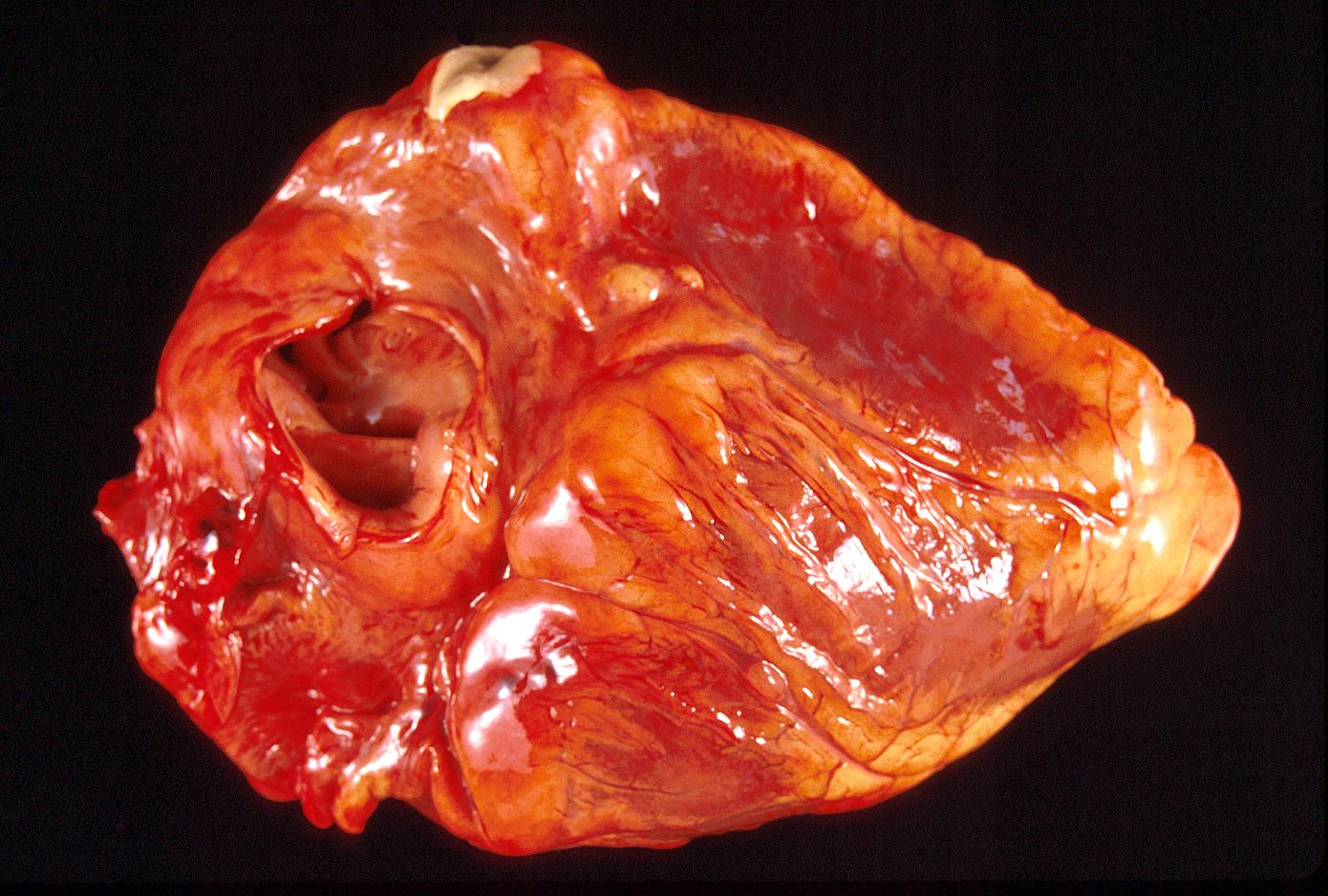 |
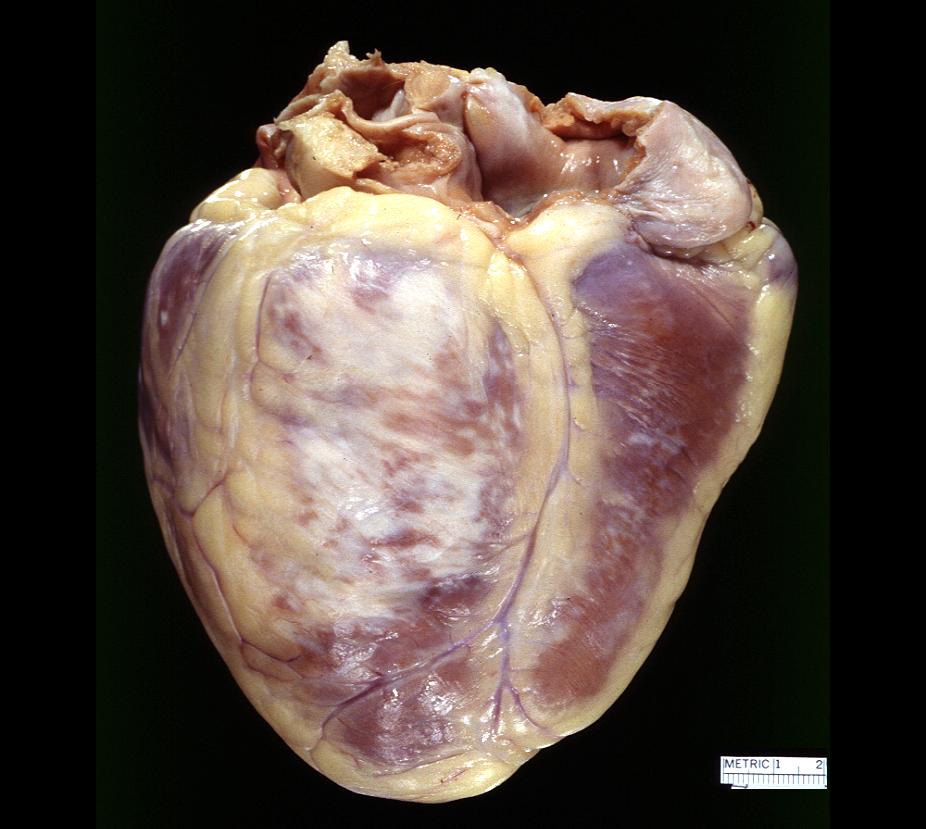 |
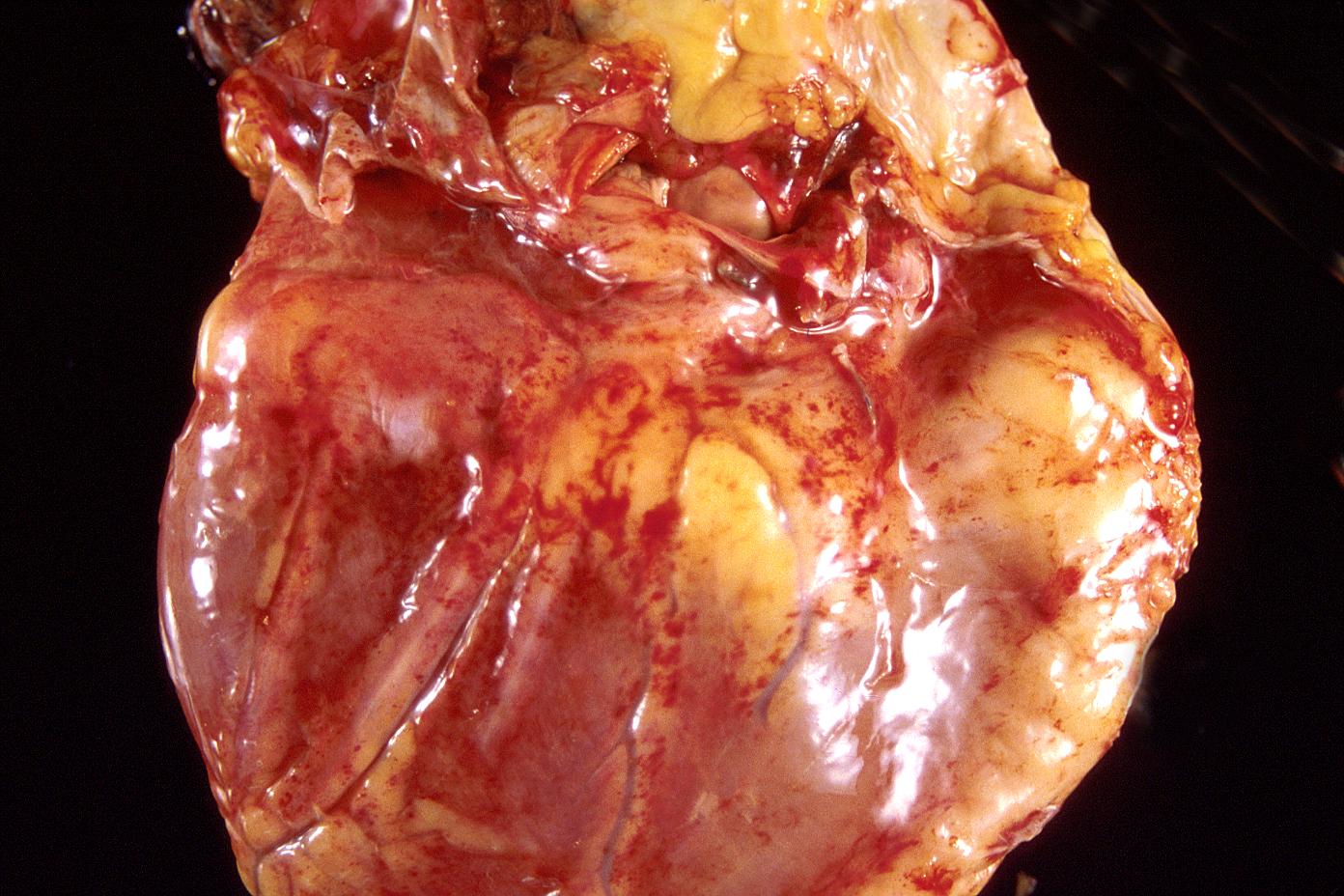 |
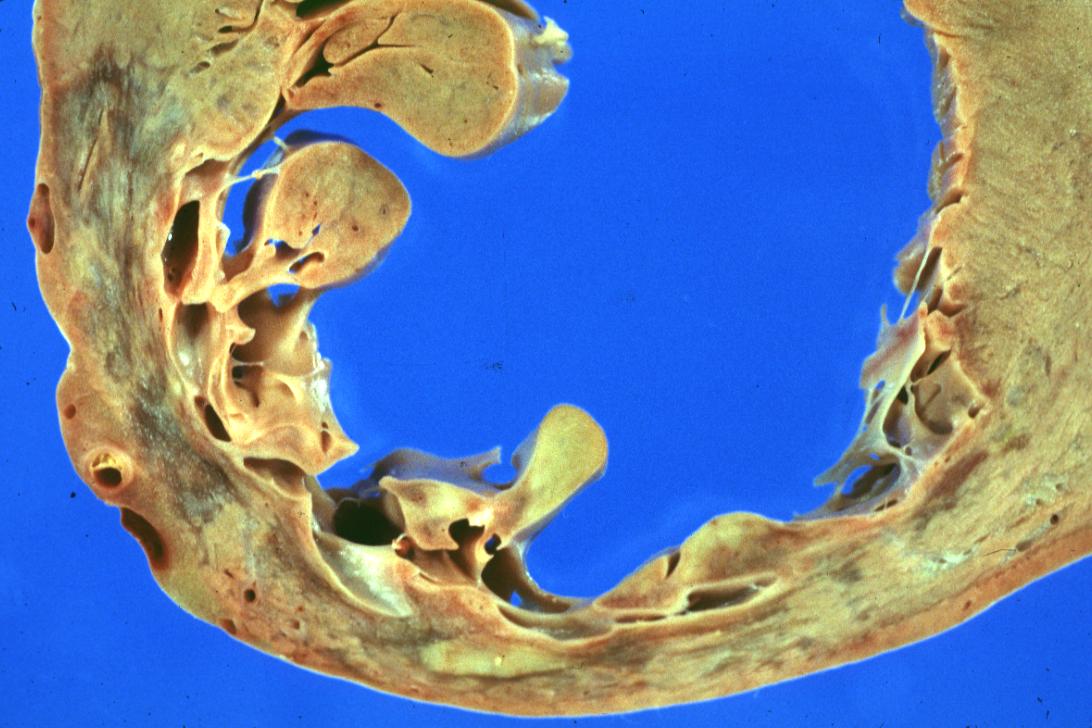 |
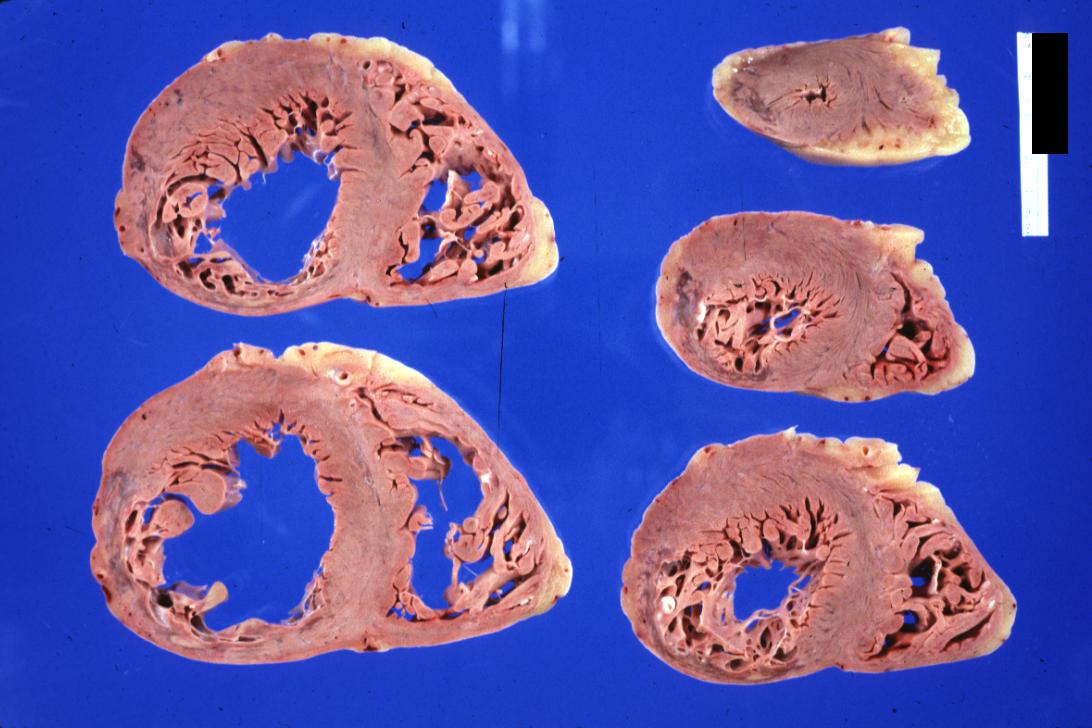 |
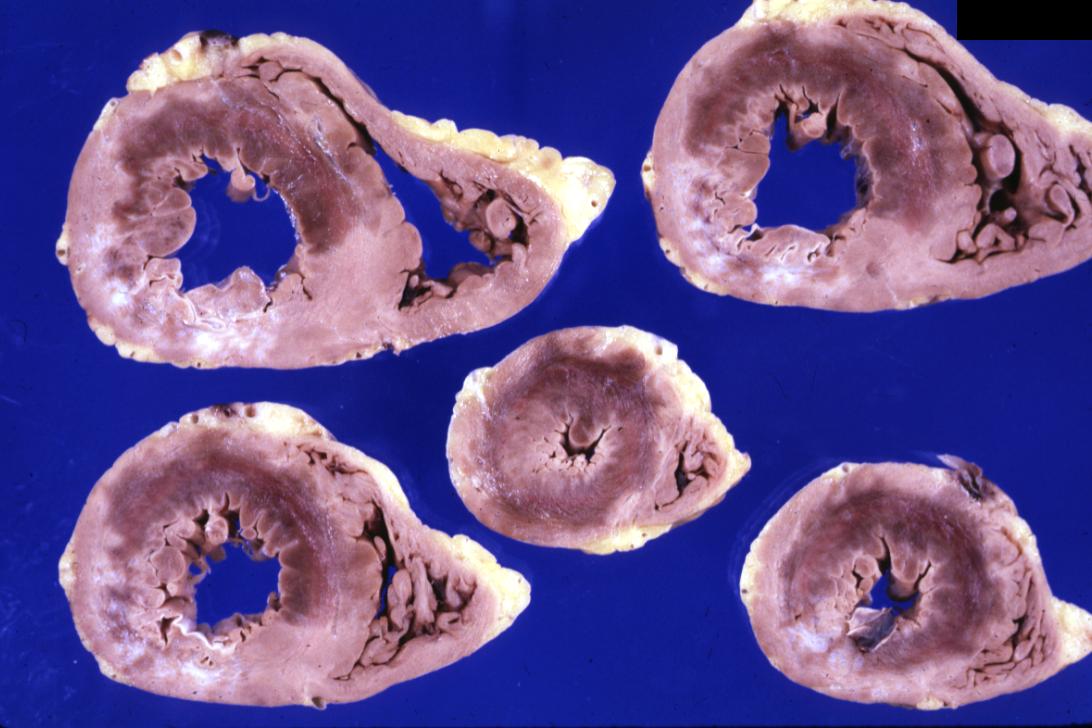 |
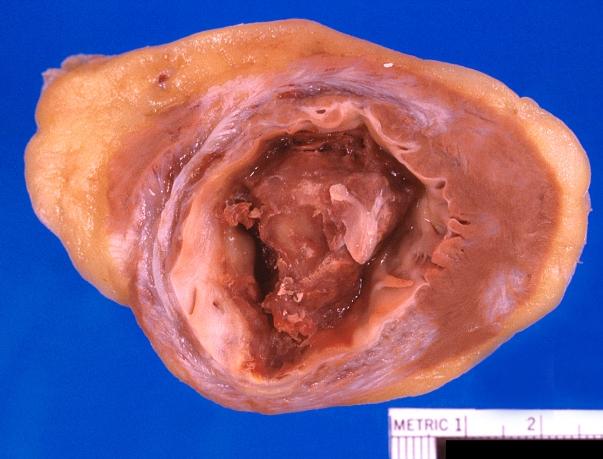 |
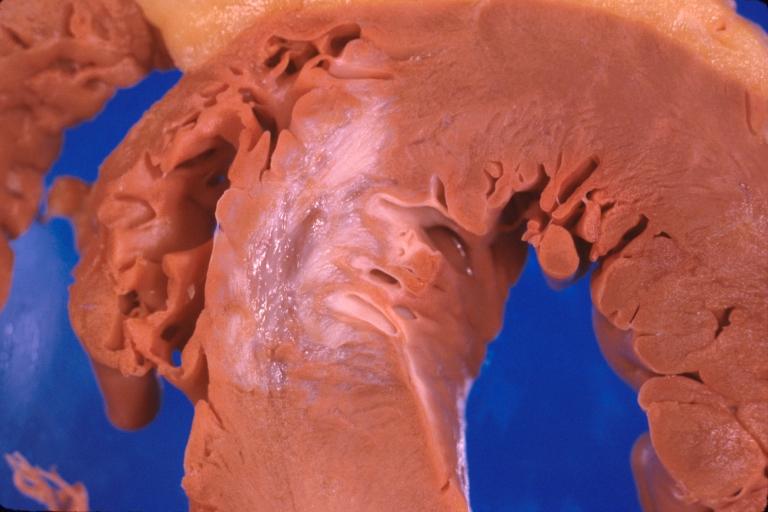 |
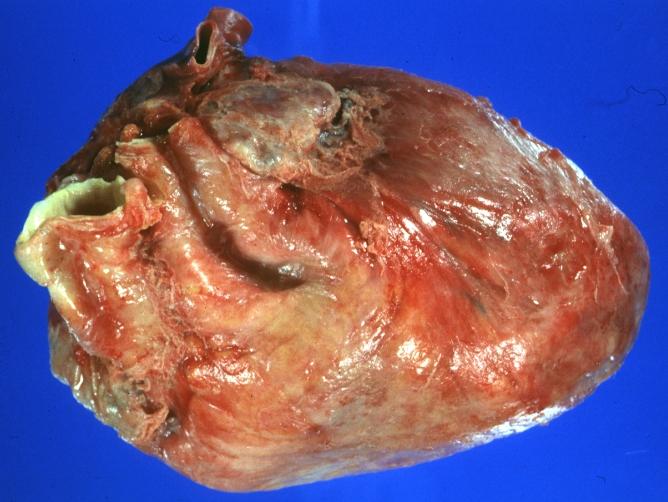 |
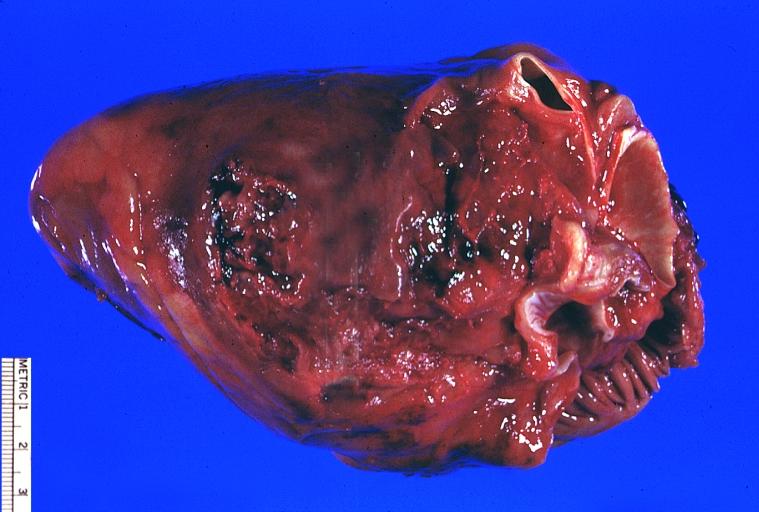 |
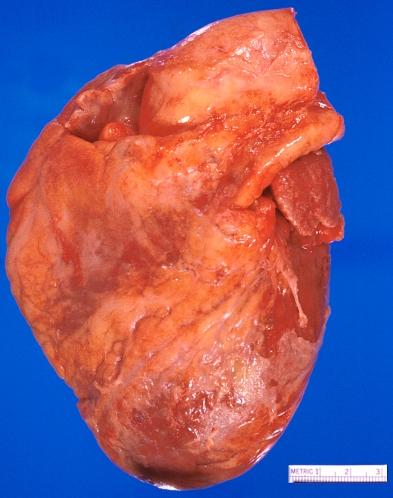 |
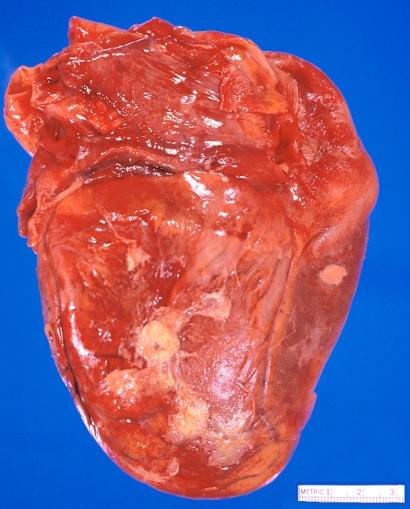 |
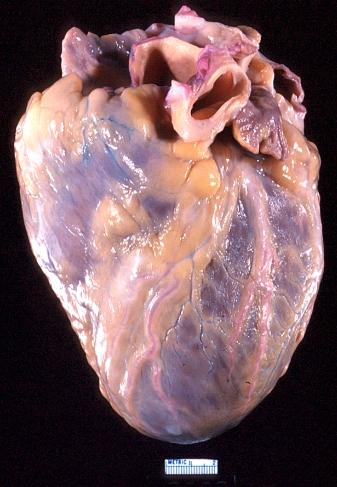 |
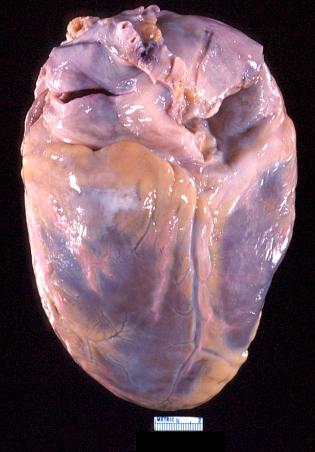 |
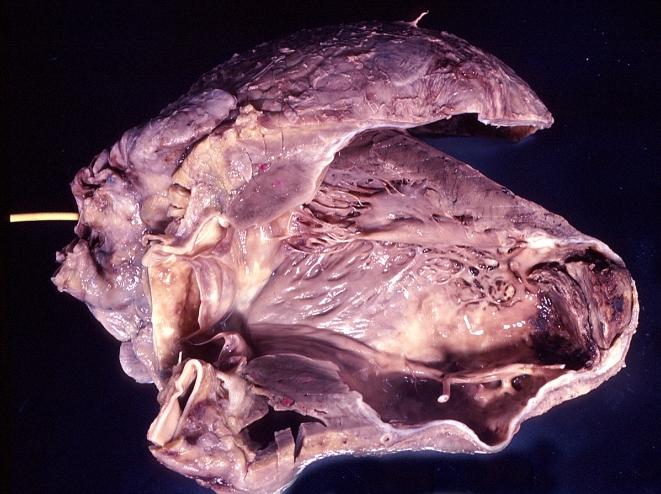 |
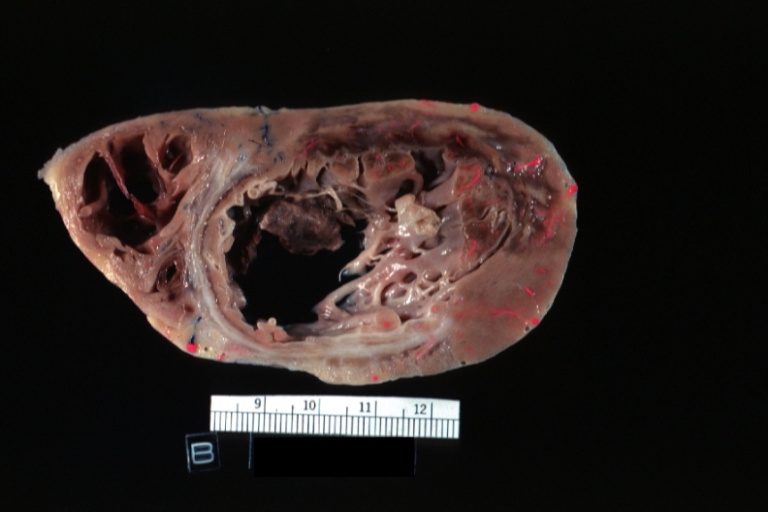 |
